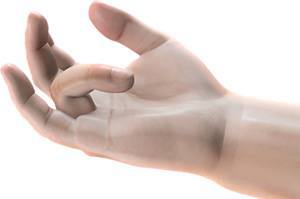Dupuytren’s Contracture

Dupuytren’s Contracture is a hand condition where thickening of the underlying fibrous tissues of the palm cause the fingers to bend inward. Patients with this condition are unable to fully straighten the affected fingers.
It is caused from excessive production of collagen which is deposited under the skin. It commonly occurs in the ring finger and little finger. Occasionally the middle finger is affected but the thumb and index finger are rarely affected. Dupuytren’s contracture is a condition that usually progresses slowly over many years and is not usually painful. However, some cases may progress rapidly and be painful to the patient.
Symptoms
The most commonly observed symptoms of Dupuytren’s contracture are lumps or nodules in the palm, difficulty in straightening the finger, and contracture of the nodules which forms tough bands under the skin.
Causes and Risk Factors
The cause of Dupuytren’s contracture is unknown. However, there are certain risk factors that may increase your chance of developing the condition. These can include the following:
- Age: It occurs more frequently around ages 40.
- Social Habits: Smoking and drinking alcohol may increase your risk of developing the condition
- Medical Conditions: Patients with diabetes, alcoholism, cirrhosis of the liver, and seizure disorders appear to be at increased risk of developing the condition.
- Gender: The condition is more common in males than females.
- Heredity: The condition tends to run in families.
- Ancestry: Most commonly affected are northern Europeans and people of Scandinavian descent.
Diagnosis
Hand and wrist conditions should be evaluated by an orthopedic hand surgeon for proper diagnosis and treatment. Your surgeon will collect medical history and perform physical examination. Dupuytren’s contracture is diagnosed based on the history and physical and without any special testing required.
Treatment
You may not need treatment for Dupuytren’s contracture if the condition is not affecting your ability to perform daily activities. However, if you are experiencing pain or if having difficulty using your hands for everyday activities, your surgeon will recommend conservative treatment options to treat your condition. Treatment options will vary depending on the severity of the condition. The conservative approaches include:
- Heat: Applying heat to the palms of the hand prior to massage or exercise can help to loosen the tissues.
- Massage: Gently massage the thickened tissues of the palm.
- Exercises: Stretching exercises such as bending the fingers away from the palm may be useful.
- Injections: Steroid injections in the palm may be done to relieve local inflammation.
- Needle Aponeurotomy: This procedure involves inserting a small needle into the thickened palm tissue and manipulating it to loosen and break up the contracting tissue. Ultrasound may be used to guide the needle to avoid hitting nerves or tendons.
- Collagenase Injection: An enzymatic drug that breaks down collagen can be injected into the corded tissue to soften and weaken the contracture. The physician then manipulates the tissue manually to break up the tissue.
Surgical Procedure
If conservative treatment options fail to resolve the condition and symptoms persist for 6 months or more and your quality of life is adversely affected, your surgeon may recommend you undergo a surgical procedure to open the tendon sheath and allow more room for tendon movement.
This surgery is usually performed in an operating room under local or regional anesthesia on an outpatient basis as day surgery. Your surgeon makes a small incision to the affected palm area.
The surgeon then removes the thickened fibrous tissue causing the contracture.
The incision is then closed with sutures and covered with a sterile dressing.
Complications
Complications can be medical (general) or specific to hand surgery. Medical complications include those of the anesthetic and your general wellbeing. Some of the complications associated with the surgery include:
- Infection
- Nerve damage causing weakness, paralysis, or loss of feeling in the hand area
- Injury to the arteries of the fingers/hand
- Recurrence
Dupuytren’s Contracture is a hand condition affecting a patient’s ability to straighten the affected fingers. Thickening of the underlying tissues in the palm of the hand affect the tendons ability to move the fingers freely leading to a fixed contracture where the affected finger or fingers are bent in towards the palm and the patient is unable to straighten them. Consult with your doctor about various treatment options if the condition is affecting your activities of daily living.
Other Hand & Wrist List
- Trigger Finger
- Scaphoid Fracture
- Arthritis of the Wrist
- Flexor Tendon Injuries
- Wrist Pain
- Ganglion (Cyst) of the Wrist
- Wrist Tumours
- Arthritis of the Hand (Digit Arthritis)
- Wrist Fracture
- Hand Fractures
- Ligament Injuries
- Tendinitis
- Tendon and Nerve Lacerations
- Normal Hand Anatomy
- Carpal Tunnel Syndrome
- Arthritis of the Thumb

 Menu
Menu






